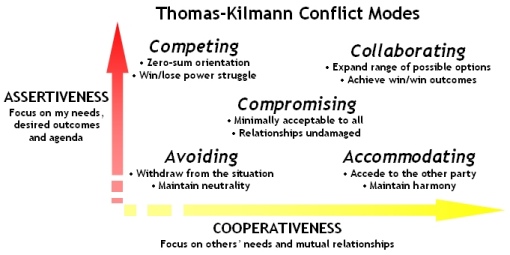Understanding Conflict Management
Conflict Styles
Styles may vary from one situation to the next.
- Compromising: both sides agreeing to make small or superficial concessions.
Both parties make concession and bargaining to and reach a settlement to which both agree. - Accommodating: cooperation wherein one side agrees to other's wants.
Usually occurs when the outcome of the situation is very important to one person but less so to the other.
- Collaborating: meeting underlying needs of both parties.
It allows assertiveness and cooperation in the search for a solution that meets the needs of all. - Competing: is used when outcome is more important than relationship, e.g., in emergencies.
This also involves assertiveness but not cooperation. - Avoiding: can mean running away but evasion or delay can be appropriate and constructive.
This approach can be useful in highly emotional situations where time is needed to gain perspective.

Take an Online Style Quiz?
You can get a sense of your own conflict style by taking an online style inventory developed by the Peace and Justice Support Network of the Mennonite Church. This is an optional activity, so decide for yourself if it makes sense in your circumstances.
Licensed under the Creative Commons Attribution-NonCommercial-ShareAlike 2.5 License
Brought to you by CReducation.org.